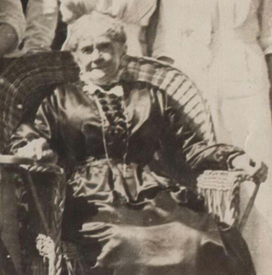The Mother of Hayward
Written by Diane Curry, Hayward Area Historical Society | Download a PDF of this article
Rachel Hayward, c. 1900
In looking at Hayward’s history, it is expected and appropriate that a great deal of attention be given to William Hayward, the city’s namesake. But, as with most famous men in history, there is a woman behind the man who helped make it all possible. Rachel Hayward is the woman behind the man in this case. She was often called the “Mother of Hayward,” because of her work, care, interest, and attention to the growing town. Though much of her life remains a mystery at this point, there are enough clues to paint a picture of her life.
Rachel Hayward was born Rachel Rhodes (sometimes spelled Roads) in Layette, Indiana in 1831. Little is known of her early life but she apparently married a C.Z. Bedford around 1848 in Tippecanoe County, Indiana when she was 17 years old. She had at least one child who survived to adulthood from this marriage, her daughter Mary, born around 1851.
In 1858, Rachel came to California leaving her daughter temporarily in the care of her parents. Her husband probably died around that time as she claimed later in life that she was a widow. Her sister, Emiline Hamer and her family, had come out to California a few years prior making their home in the East Bay. Rachel may have stayed with her sister a short time, and by 1860, she is listed in the census living in the home of a cousin in San Lorenzo and working as a seamstress.
Rachel disappears from the historical record again for a few years and she never said much about her life prior to coming to Hayward. In 1866, Rachel with her daughter Mary, who had joined her mother in California at some point, made a fateful stagecoach ride to the little town of Hayward. She probably came to town to visit Emiline who had just moved to the area. Emiline’s husband died the year prior and she had just purchased three acres and a house at B Street and First Street (Foothill Boulevard today). Emiline had four children of her own and may not have had room for her sister and niece so Rachel got a room at the Hayward’s Hotel.
The hotel was the main attraction in town. It sat at the top of the hill on roughly the northwest corner of A Street and Main Street. William Hayward had begun building the structure in the mid-1850s and it evolved through many additions and renovations over several decades into a majestic hotel. At the time of Rachel’s arrival, the hotel consisted of 25 rooms. The entire town had just a handful of businesses and houses located in the blocks between A Street and D Street and from Second Street to Watkins Street. Less than a 1000 people made their home here.
Rachel and William Hayward struck up a friendship. They were both widowed with daughters, though William’s daughter Louisa was actually close to Rachel’s age. Their friendship turned into a courtship and in April 1866, William and Rachel married at her sister’s home. The couple then left for a six-month honeymoon in the Sierra foothills. It is unclear if they were simply taking a sojourn around Mr. Hayward’s old mining stomping grounds or if they were doing a little prospecting themselves. For part of the trip, Rachel was pregnant with the couple’s only son, William Martin, born March 1867. Rachel was 37.
William Hayward had diverse business interests throughout town. To keep the main source of income going, and while caring for her family, Rachel essentially became the manager of Hayward’s Hotel. It seems that most of those renovations and additions to the hotel happened under her watch. Hotel guests and Hayward residents perceived her as the premier hostess in town. The hotel became known for its accommodations not only because of the quality of the rooms but also for the celebrations held at the hotel and the good food. Rachel was considered a great cook and it is likely that she cooked for special occasions and also supervised additional cooks in the kitchen.
Hayward’s Hotel, c. 1920. The hotel, which started as a modest structure, was expanded and remodeled.
Throughout the 1870s and 1880s, all the big social events in town were held at Hayward’s Hotel. Rachel knew everyone in the area and they all knew her. A quote from the local newspaper editor said, “To have known Mrs. Hayward was a rare privilege, and many there are who came in touch with her charming personality.” She also participated in local social organizations such as the Farm Bureau, the Rebekah Lodge, and later the Hill and Valley Club.
William Hayward died in July 1891 having suffered for some time from cancer. His will stipulated that all his holdings be sold, including the hotel, with the proceeds (which amounted to well over $100,000) going in part to his two children, Louise and William, and the largest percentage going to Rachel.
The following year, Rachel’s niece, Lulu Hamer, committed suicide at her mother’s home on B Street. Rachel then lost her son, William, to a bout of pneumonia in November 1893. He was 26 years old. During this time, the hotel was owned and operated by someone else but Rachel’s connection to the hotel had not ended. A large article in the local newspaper also in November 1893 announced that Rachel was back in charge of the hotel and busy redecorating with all new furniture and carpets. She planned to host a reception to celebrate her return to her managerial duties when the redecoration was complete. There was no follow-up to this announcement so the death of her son may have curtailed Rachel’s plans for a celebration.
Anniversary party for George and Emma Oakes. Rachel Hayward, a good friend of Emma’s, stands in a place of honor in the center of the photo, 1901
By 1900, Rachel was living with her daughter Mary and her family in Oakland. Rachel may have retired by this time. She eventually returned to Hayward and lived at the hotel where she died in 1917 at age 86. Her funeral was one of the largest held in town. George W. Frick, Superintendent of Oakland Schools and former principal of Hayward Union High School, gave the eulogy followed by a tribute from the president of the Hill and Valley Club. Town officials, businessmen, and friends all attended and were part of the procession from Eden Congregational Church to her final resting place beside her husband at Lone Tree Cemetery.
The esteem and fondness residents of Hayward held for Rachel was summed up nicely in her obituary, “…ever since those early days 59 years ago, has her life and good works been identified with Hayward’s best interest. It was to her as it were, a child of her own heart to love and foster, to hope and plan for, and all this she did with a mother’s love and fidelity, and because of her loving care she became known as the honored mother of Hayward.”
This article originally appeared in the Tri-City Voice.



